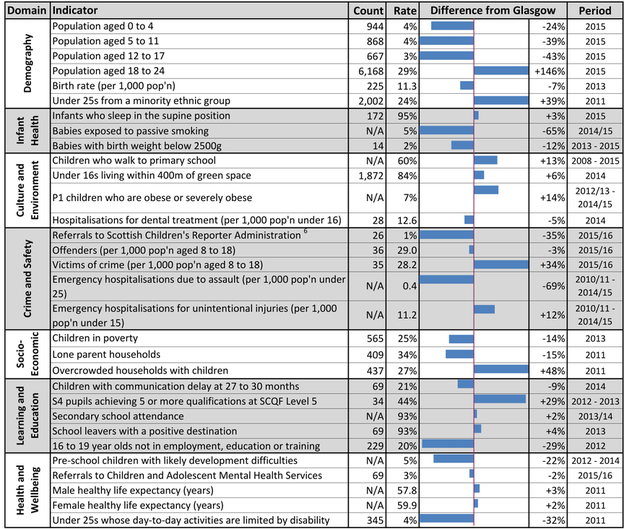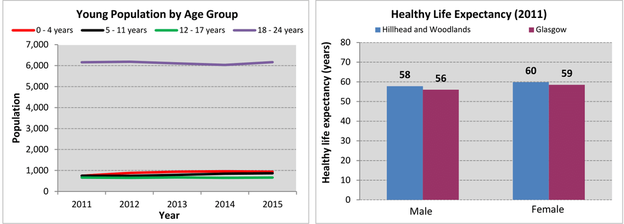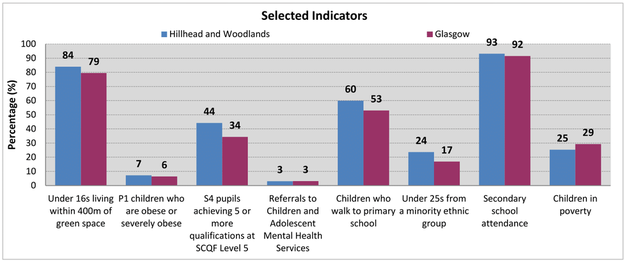Hillhead and Woodlands
Children and Young People's Profiles
*Please note that this profile is based on data from the 2011 Census.*
Download a printer friendly version of this profile (pdf)
Hillhead and Woodlands has a population of 8,647 children and young people (aged 0-24 years).

Neighbourhood Comparisons with Glasgow
18-24 year olds account for 29% of the population in Hillhead and Woodlands. 24% of under 25s are from a minority ethnic group. 84% of children live within 400m of green space. The neighbourhood has fewer babies exposed to passive smoking (-65%) but more overcrowding (+48%) than in Glasgow overall. S4 pupil attainment is higher (+29%) than the Glasgow average and 93% of children leaving school go onto a positive destination (higher/further education, employment or training). Likely development difficulties in pre-school children are lower than the Glasgow average (-22%) and communication delay in young children is also lower than average (-9%).

Neighbourhood Trends

The number of 12-17 and 18-24 year olds in Hillhead and Woodlands has remained steady since 2011, while the number of 0-4 year olds has increased by 26%. Healthy life expectancy for males is approximately 2 years higher than Glasgow as a whole and 1 year higher for females.

Pupil attainment and P1 obesity levels in Hillhead and Woodlands are higher than the Glasgow average, while child poverty is lower. More children than average live in proximity to green space and primary school children are more likely to walk to school when compared to Glasgow overall. Secondary school attendance and the proportion of children and young people from minority ethnic groups are higher than the Glasgow average while referrals to children and adolescent mental health services are on a par with Glasgow overall.
Notes
1. Data sources: Census 2011, GCPH, Glasgow City Council, HMRC - Child Poverty Unit, ISD Scotland, National Records of Scotland (NRS), Transport Scotland, Sustrans, Police Scotland, the Scottish Government and the Urban Big Data Centre, Glasgow University.
2. Indicators are aggregated using latest available datazone (2001 or 2011); neighbourhood boundaries based on 2001 datazones.
3. All count figures of less than 5 (denoted as ‘< 5’) have been suppressed to avoid any potential identification.
4. Populations presented in the population trend chart, also used to calculate healthy life expectancy estimates, use NRS small area population estimates for the years 2011 - 2015.
5. ‘Healthy life expectancy’ is an estimate of the average number of years people are likely to spend in good health. It is calculated using population estimates, death registrations and self-assessed health from the 2011 Census.
6. Denotes children referred to the Scottish Children’s Reporter Administration for an offence or non-offence related reason.
There is a downloadable document providing detailed notes and definitions on the information presented in this profile.
There is a downloadable Excel workbook containing the data used in all of the profiles. This workbook also includes alternative output formats and further breakdowns of some of the variables.